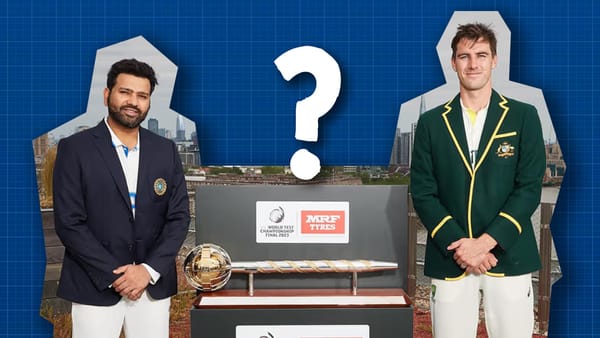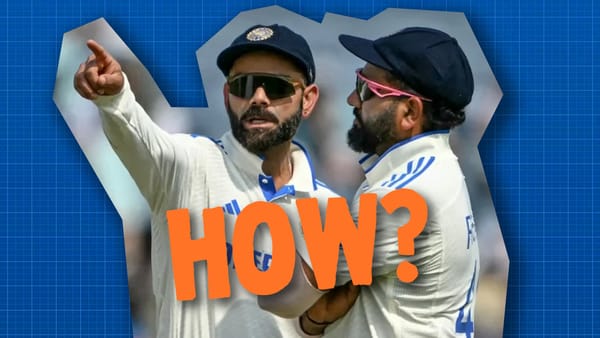The new creature called LBW
With the advent of TV, and then eventually DRS, LBWS have changed and that means so has cricket.
Welcome to Jarrod Kimber’s Sports Almanac, a cricket, sport and Jarrod Kimber related newsletter focusing on global themes of cricket, sport and random pop culture sporting takes. Please sign up and share violently.
Leg before wicket is not what it used to be. If you're old enough to have watched cricket in the 90s and earlier - or just been glued to old highlights on YouTube - you'll know the LBW has changed. They are a different creature now.

For Red Inker, I talked to Karthik Krishnaswamy about all these changes, because we are uber cricket nerds. Karthik even seems to have a diary on what batsmen are backlift up or toe-tappers.
Before channel nine and four changed cricket with TV gimmicks. Getting hit on the thigh pad - or the helmet like Sachin Tendulkar - wasn't enough to receive a not out. But it wasn't all great for bowlers, because they made decisions like leg stump didn't exist. And then there were the spinners. If you got a stride in (one of the great phrases in cricket), the chances were you wouldn't be out. For the batsmen who left the ball, they were essentially told to use their bat by umpires. If the leavers had it tough, tailenders struck on the pads might as well have walked.
The obvious change is DRS. But the interesting thing is that LBWs changed before it was implemented. It started in the early 2000s, although DRS didn't arrive properly until 2008. And this was because we could see things we'd never had access to before. The stripe down the middle of the wicket told us where the stumps were and made us focus less on where the batsmen were standing. Then the batsmen started disappearing, well, more fading so we could get an idea what balls might hit the stumps.
The significant change was Hawkeye. Suddenly batsmen thrusting their pads down the wicket seemed out, everything was clipping leg stump, and quick bowlers went over the stumps.
And what happened was seamers started taking fewer LBWs at the same time spinners took more. Spinners as it turns out, don't bounce the ball over the stumps much, and seamers do. As these things went on, leaving the ball, LBWs have faded from the game. Tailenders are still stung occasionally, but at the top level of the game, those umpiring decisions are there to "move the game forward" are harder to make because they will overturn the decision.
The data backs up the seam and pin swap, and numbers are suggesting the leave LBWs have disappeared. The number 11 decisions are something I'd love to look up, but haven't yet.
There are other things we can't look up with LBWs, and that's how they would change the specific players careers. But I want to look at two players.
When I first saw Graeme Swann bowl, I thought he was a good first class spinner. You could see that he could play a few Tests, but perhaps not make an enormous impact. It's possible I underrated him, but a finger spinner without an other one, wasn't what people were looking for. Non-Asian off-spin had almost disappeared after uncovered wickets took over. West Indians had given up spin, Australia only liked leggies, New Zealand had Vettori and the last offspinner from England with over 100 Test wickets was John Emburey. He began his first class career in 1973.
In 2002 spinners took 16% of their wickets with LBWs, in peak Swann years that number was often up at 24%. If that doesn't sound many, it's a third more. But it wasn't just the LBWs that Swann and other finger spinners like Lyon, Ashwin and Jadeja took, it was also changed the way batsmen had to play them. The front pad was no longer a form of defence, it was now a target, and it had to be moved, bringing in other dismissals.
It was that front pad that became a problem for Shane Watson. It probably would have been anyway, as it was always a bit in the way. But as batting became less about being in the ball's way, Watson was always in its way. That big front step would have been handy all the way up to professional cricket, but Watson's breakthrough at the international level was right when DRS had taken over, and the giant stride wasn't that important. I still believe they misplaced Watson in the order, I think he came back seeing the ball well, made some runs opening the batting, but ultimately he didn't think like an opener, and so really struggled to turn starts into something more. But overall he was undervalued as a Test player, it's just I saw him when he was young, and I saw him in his best Test form, I think he was capable of more. But he couldn't move that massive leg.
Not that Swann was only good because of this, or it ruined Watson. Other players changed their styles better than Watson, and Swann worked out had to exploit these changes so well he'd end up with a better Test average than in first class. These sorts of change happen in cricket, and part of being the best in the game is changing how you play when it is needed.
And LBWs have changed in cricket, and to tame this new beast, cricket has changed how we bat, bowl and umpire them.




